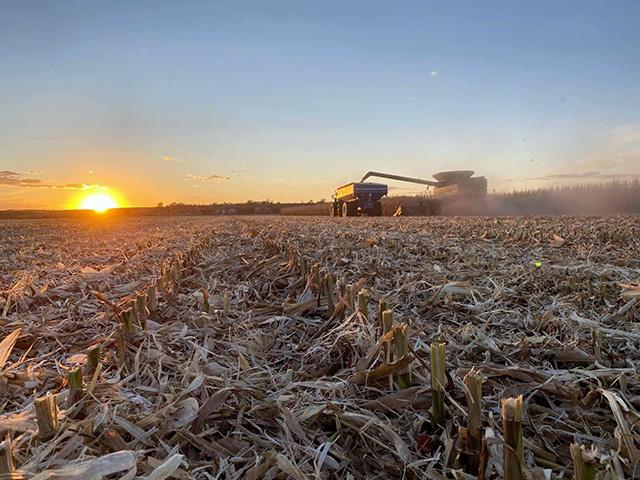Nebraska Farm Income Expected to Rise
Higher Nebraska Crop Production Not Expected to Offset Lower Prices in 2023
LINCOLN, Neb. (DTN) -- Nebraska's total net farm income is projected to rise by about $100 million in 2023 to around $7.3 billion after taking a drought hit in 2022, according to a new report from the University of Nebraska-Lincoln's Center for Agricultural Profitability and the University of Missouri's Rural and Farm Finance Policy Analysis Center.
Nebraska agriculture took a bit of a different turn in 2022 than much of the country, according to the report.
U.S. farm-income projections hit a new record in 2022. Income for Nebraska farmers, however, went the other direction.
The report said Nebraska ag receipts increased from 2021 to 2022 because of higher prices.
However, lower production and lower ending inventories for crops and smaller government program payments pulled 2022 farm income down "substantially" from 2021, the report said.
"Moving into 2023, lower projected crop prices will pressure farm receipts despite expected growth in acres and a return to trend yields," the analysis found.
"That downward pressure will be offset primarily by carryover crop insurance indemnities from 2022 and expected recovery in ending inventories, resulting in a slightly improved income outlook from 2023."
Analysts expect to see total crop acres grow in Nebraska in 2023 in response to "strong" 2022 commodity prices.
"Following recovery from 2022 drought levels, yield and production improved for the top eight crops plus hay," the report said.
Increased production, however, is not expected to be enough to offset lower prices. As a result, the report said, Nebraska farmers can expect to see crop receipts drop by about 12% in 2023.
Corn-planted area is expected to expand in Nebraska by almost 500,000 acres, or 5%, in 2023 along with expectations for a return to trend yields.
"Despite the increased acres, yields and production, lower corn prices will reduce receipts by $1.4 billion," the report said.
P[L1] D[0x0] M[300x250] OOP[F] ADUNIT[] T[]
It is expected Nebraska farmers will switch acres from soybeans to corn in 2023, with soybean planted area down nearly 200,000 acres. Though soybeans are expected to return to trend yields in the state, the report said lower prices are projected to cause soybean receipts to fall $400 million.
The analysts said hay and wheat acres will increase in 2023 above drought-affected 2022 levels, but the "potential remains for lingering drought concerns that impact winter wheat and first-cutting hay."
NEBRASKA LIVESTOCK
After herd liquidation in 2021, Nebraska cattle and calf inventory fell again in 2022.
"This was largely driven by drought across the state, which significantly limited quality grazing and forage options," the report said.
Cattle herd liquidation is expected to continue in 2023, according to the analysis.
"Beef cow inventory does not rise until 2024 as higher cattle prices will eventually incentivize a turn to heifer retention," the report said.
Despite tighter inventories in 2023, cattle and calf receipts will rise $506 million, according to the projections. That will be driven by higher prices as the "liveweight basis of marketings declines 4% year-on-year."
Nebraska hog and pig receipts are expected to decline $117 million in 2023, resulting from weaker prices and fewer marketings.
Overall livestock receipts in Nebraska are projected to increase by $300 million in 2023, the report said.
AG EXPENSES
The report said export restrictions, high natural gas prices and production disruptions contribute to record fertilizer expenses. Those expenses increased $791 million, or by about 43%, in 2022 after sharp increases in 2021 as well.
"Fertilizer expenses should level off in 2023 but are not likely to fall back for at least another year," the report said.
Feed expenses in Nebraska increased by $513 million in 2022 on short feed supplies but are expected to moderate in 2023.
Fuel and oil expenses increased $279 million in 2022 after sharper increases in 2021 but are projected to fall modestly in 2023.
KEY CONSIDERATIONS
The report's authors said prices for many crops have been at or near record nominal levels in the 2022-2023 marketing year in the U.S.
"Unfavorable weather reduced crop production in the United States, the Russian invasion of Ukraine limited exports by a major competitor in world markets and world economic growth supported demand," the report said.
"If weather conditions allow crop yields to return to trend-line levels in 2023, prices for corn, soybeans, wheat, cotton and many other crops are likely to fall."
Higher fertilizer, fuel and feed costs contributed to a "very sharp increase" in farm-production expenses in 2022.
"A smaller increase is projected in 2023 and lower prices for some inputs result in a reduction in production costs in 2024 and 2025," the report projects.
Crop losses in 2022 resulted in "high budgetary costs" for the crop insurance program in fiscal year 2023.
"Crop insurance accounts for 45% of projected spending on major farm-related programs over the next decade," the report said.
Read the full report here: https://cap.unl.edu/….
Todd Neeley can be reached at todd.neeley@dtn.com
Follow him on Twitter @DTNeeley
(c) Copyright 2023 DTN, LLC. All rights reserved.



